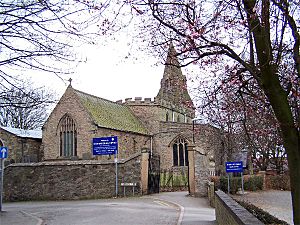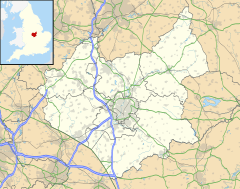Shepshed facts for kids
Quick facts for kids Shepshed |
|
|---|---|
 St Botolph's Church, Shepshed |
|
| Population | 14,875 (2021) |
| OS grid reference | SK475195 |
| District |
|
| Shire county | |
| Region | |
| Country | England |
| Sovereign state | United Kingdom |
| Post town | LOUGHBOROUGH |
| Postcode district | LE12 |
| Dialling code | 01509 |
| Police | Leicestershire |
| Fire | Leicestershire |
| Ambulance | East Midlands |
| EU Parliament | East Midlands |
| UK Parliament |
|
Shepshed is a busy market town in Leicestershire, England. It is part of the Charnwood area. In 2021, about 14,875 people lived here. Shepshed is the second largest town in the Charnwood area, right after Loughborough.
The town was once called Sheepshed or Sheepshead. This name came from its strong connection to the wool industry, where sheep's wool was very important.
Contents
History of Shepshed
How Shepshed Started
Shepshed first grew because of the wool trade. People used to argue about where the town's name came from. The oldest name found is Scepeshefde Regis in the Domesday Book from 1086. This means "King's hill where sheep graze." The word 'Regis' shows that a royal lodge, like a hunting lodge for a king, was once in the area. The name changed many times until it became Shepshed in 1888.
Not much is known about Shepshed before the Domesday Book. But its name is definitely Anglo-Saxon. Some local history books say that two of Shepshed's roads, Ring Fence and Sullington Road, are very old. Sullington Road is thought to be an ancient British path named after a goddess called Solina. In Anglo-Saxon times, Shepshed was probably just a small village in a large forest.
Over the next few centuries, Shepshed became more important. Its success in the Middle Ages came from the wool industry. A place called "Well Yard" on Forest Street might have been "Wool Yard." This is where wool merchants from places like Bradford came to buy wool from local people. There is also good evidence that Shepshed had a weekly market until at least the 1300s.
St Botolph's Church
The Parish church of St Botolph was built in the 1000s. It is the most western church in England named after St Botolph. After the Norman Conquest in 1066, the church and its land, Oakley Wood, were given to Odo of Bayeux. He was the half-brother of William the Conqueror. The land went back to the Crown several times, including in 1534.
There is a wooden carving in the church that shows Queen Elizabeth I visiting. It's not clear if the Queen actually came to Shepshed. If she did, it would have been the farthest north she traveled in England. The oldest part of Shepshed is still built around this church.
The church was originally supported by Leicester Abbey. But between 1699 and 1856, the Phillips family of Garendon Hall supported it. This family owned the land since Sir Ambrose Phillips bought it in 1683. Garendon Hall was built where Garendon Abbey used to be. Garendon Abbey was a very important Cistercian monastery. It was started in 1133 by Robert de Beaumont, 2nd Earl of Leicester. The Abbey was closed by Henry VIII in 1536. Garendon Abbey made a lot of money from sheep farming.
Shepshed in Later Centuries
In the 1700s, the common lands around Shepshed were enclosed. This means that shared land was divided up and fenced off for private owners. Some land had been enclosed earlier, but by the late 1700s, about 2,000 acres (8 square kilometers) of common land were divided among the main landowners in the village.
Shepshed also experienced an 'earthquake' on September 30, 1750. The vicar of St. Botolph's church, Reverend Thomas Heath, wrote in the church records: "Sept 30, 1750, this day (Sunday), while I was administering the Sacrament, between the hours of 12 and 1 o’clock, I and the congregation were very terrible of the shock of an earthquake."
A big fire caused a lot of damage in the town on June 30, 1753. Eighty-five buildings were destroyed. This fire happened at a place now called Hall Croft, named after a school that burned down in the fire.
The 1800s brought many changes. Shepshed was briefly connected to Loughborough and coal mines by the Charnwood Forest Canal. This canal opened in 1798, but it did not last long. The next year, a dam at Blackbrook Reservoir, south of Shepshed, broke. This caused big floods in Shepshed and Loughborough. By 1804, the canal was not making money and was closed. Today, modern roads and paths still follow where the canal used to be.
The Charnwood Forest Railway opened in 1883. People called it the "Bluebell Line" because of all the bluebell flowers nearby. Regular passenger trains stopped running in 1931. However, goods trains continued until 1963. Shepshed railway station is no longer there. Part of the old railway line is now a path for horses and walkers between Shepshed and Thringstone. This includes an old bridge called a viaduct at Grace Dieu.
Education in Shepshed
The main school in Shepshed is Iveshead School. It teaches students from ages 11 to 19. Students come from Shepshed and nearby towns and villages like Loughborough, Kegworth, and Castle Donington.
There are four primary schools in Shepshed. Three of these schools, Oxley, St Botolph's (which was recently taken down), and Newcroft, send their students to Iveshead. The fourth primary school, St Winefride's, is for Roman Catholic students until they are 11. After that, most of them go to De Lisle College in Loughborough. Newcroft Primary School became Newcroft Primary Academy in 2016.
Transport
Shepshed is located close to junction 23 of the M1 motorway. The closest train station is Loughborough railway station. East Midlands Airport is only seven miles away.
Buses
Several bus services run through Shepshed. Arriva Midlands buses (16/16A and 126/127) offer frequent trips to Loughborough and Coalville. Diamond East Midlands' route 129 connects Loughborough and Ashby. The Skylink Nottingham-Coalville bus, run by trentbarton, also links Shepshed to East Midlands Airport and Nottingham.
Sports in Shepshed
Shepshed has several sports teams. The town's main football team is Shepshed Dynamo F.C.. They play in the Northern Premier League at the Dovecote Stadium. Ingles F.C. also has two football teams. Their first team shares the Dovecote Stadium with Shepshed Dynamo. Their reserve team plays at Little Haw Lane. Ingles F.C. has moved up quickly in leagues since 2013.
Shepshed Cricket Club was formed in 2015. It was created when the town's two existing cricket teams, Shepshed Town and Shepshed Messengers, joined together. Shepshed Town started in 1869 and was one of the top cricket clubs in Leicestershire. After the merger, the club now has four senior teams and junior teams for Under 15, Under 13, and Under 11 players.
The main Rugby team in Shepshed is Shepshed RFC. They train and play at the Hind Leys Campus. The club started in 1985. They won the LRU Division 4 in 2014 and the LRU Division 3 in 2015.
Notable People from Shepshed
- Bruce Woolley – A musician, singer, songwriter, and record producer who lived in Shepshed.
- Kiernan Dewsbury-Hall – A footballer who grew up in Shepshed.
Shepshed Fire Station
Shepshed has a retained fire station. This means firefighters are on call and respond from home or work when needed. It is part of the Leicestershire Fire and Rescue Service (LFRS). The station is on Charnwood Road.
The current fire station opened in 2002. It replaced an older station built on the same spot in 1951. The new building was first used as both a police and fire station. However, the police station soon became just an office and then closed completely. This left Shepshed without a police station for many years. LFRS then took over the whole building. They now run a training center there, along with the fire station.
In front of the station, there is a memorial. It remembers two Shepshed police officers who were killed while on duty in 2002. It also honors two long-serving firefighters, one of whom died on the way to a fire in 2006. The station uses a Scania pumping truck and a Command Support Vehicle.
See also
 In Spanish: Shepshed para niños
In Spanish: Shepshed para niños


